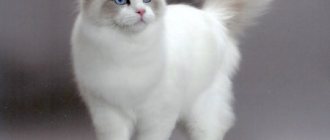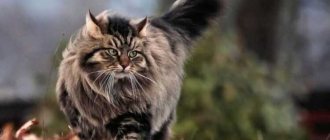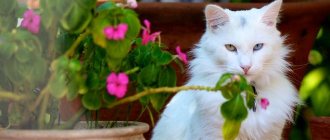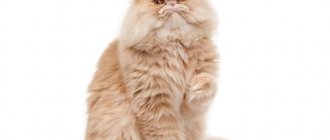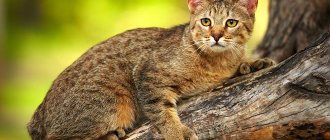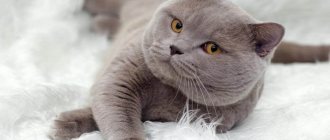The Ragdoll cat is affectionate and pliable. In addition, she is known for her lazy, phlegmatic character. By competing on these qualities, she can collect all the cups and medals in international competitions. For some people, this is an absolute flaw, but for others, it is a charming character trait.
Description of the breed
Strict standards have been drawn up for the breed, deviations from which lead to a decrease in points at exhibitions or competitions.
- Torso. These cats have a strong and large build. The croup is the same size as the shoulders. The paws are of medium size, the front ones being somewhat shorter than the hind ones. The average weight of a male is 7-10 kg, for a female - 4-6 kg.
- Head. The skull is wedge-shaped with a clear contour without interruptions or bulges. The forehead is rounded, the bridge of the nose is slightly concave.
- Ears. The ears are medium in size with a wide base and set apart. There is a slight forward tilt with slightly rounded tips. The inside of the auricle is covered with fluff.
- Eyes. They have an oval shape and a blue iris.
- Wool cover. The hair is long, silky, and may resemble rabbit skin. The difference is the practically absent undercoat.
Another difference is the fluffy “collar” around the neck and “pants” on the hind legs. There are signs that will disqualify an animal. These are:
- short paw tail;
- pointed ears;
- stocky body;
- Round eyes;
- straight nose;
- cotton wool structure;
- the presence of white on the ears and tail;
- the presence of white fur behind the corners of the eyes or its presence on the tail of a two-colored individual.
Interesting read: Norwegian Forest cats.
There is a complete disqualification, which involves a ban on reproduction for the following reasons:
- strabismus or other defects in eye shape;
- not blue iris color;
- deformation of fingers;
- insufficient width of the chest.
An animal with such characteristics cannot take part in selection and must be rejected and sterilized.
Adult ragdoll cat
Canadian or American
Many experts identify two directions in the development of the breed. This is due to different approaches of felinological organizations. In fact, these are the same cats with no differences between them.
Short-haired or long-haired
There are no short-haired representatives of the breed. These cats are always fluffy, with long hair. The hairs themselves do not tend to tangle. They are very pleasant to the touch, since the Ragdoll is a smooth-haired cat.
Material on the topic: all about the Bengal cat.
Standard and rare colors
Ragdoll kittens are born white. Their color develops around the age of two years. As a result of molting, the color may change - become richer or deeper. There are some standard colors:
- Bicolor. The color consists of two colors. The white on the head is shaped like a V. The dark color is on the forehead, around the eyes and a little on the cheeks. The back of the animal is lighter than the head or muzzle, but may be spotted.
- Mitted. Another name is “glove”. Dark markings are on the head and tail, and the main background is light. From the chin along the stomach there is a white stripe that ends only on the tail of the animal. There are boots on the hind legs.
- White. This color is only found in small kittens. Adults do not have it.
- Color point. The body is light in color, with dark markings on the paws, tail, and head. The lightest color is located on the chest and neck.
There are other types of colors that appeared as a result of breeding work:
- Strength Coat tone with a slight tint reminiscent of tan color. The markings themselves are dark brown. There are different types, such as seal bicolor or seal mitted.
- Chocolate. The wool is colored milky or ivory. The points are colored milk chocolate on a light base tone or chocolate on a dark one.
- Blue. The background color is light gray with a blue tint. The markings themselves are dark gray.
- Lilac. The main color of the coat is white, with pink-gray markings on the body.
It is worth remembering that Ragdolls' whiskers are always white, even if the animal's fur is dark. Some experts allow other colors:
- tortoiseshell;
- tabby color;
- cream;
- red.
However, they did not receive full recognition. It is worth noting that pure red color is never found in this breed. Other breed standards are shown in the table below:
Table of basic standards for the Ragdoll cat breed.
Breed standard
Neva masquerade cat of medium or large size. The differences in size between females and males are significant: a female cat weighs up to 10 kg, and a female cat weighs up to 6 kg. Breed characteristics:
- the head is massive, proportional, wide trapezoidal in shape,
- the forehead is low, smoothly transitions into a straight, wide bridge of the nose,
- nose is medium in length, wide,
- jaws are well developed, strong,
- low cheekbones and full cheeks,
- the chin is strong, wide, but not protruding,
- short but strong and muscular neck,
- the ears are medium in size, with a wide base, rounded tips and the presence of tassels and brushes, the outer edge of the base should be above eye level, and the ears themselves are slightly tilted forward, the distance between the ears should be greater than the length of the base of one ear,
- the eyes are large, set slightly obliquely and wide, the outer corner is rounded, the inner corner is elongated,
- eye color - shades of blue and cyan, the tone should be uniform and rich,
- body type - heavy (substantial),
- the skeleton is strong, the muscles are developed and pronounced,
- the body is massive, dense,
- limbs with the body form a rectangle,
- wide chest,
- the feet are round and large, there are tufts of hair between the toes,
- tail with a rounded tip, heavily pubescent, almost reaching the shoulder blades.
The Neva Masquerade is considered a semi-dino-haired breed. Main characteristics of wool:
- hairs are shiny and harsh, water-repellent,
- from the shoulder blades to the croup the coat lengthens,
- on the sides it becomes softer and more snug,
- double undercoat: summer - short, close, winter - very long, abundant, dense,
- the decorating hair is long and dense, the mane, frill and collar are thick, the “pants” are dense and fluffy,
- the shortest hair is on the shoulder blades,
- During the molting period, almost nothing remains of the decorating hair.
Decorating hair is a felinological term that describes increased hair growth on certain areas of the cat's body. It is “decorating” because there is no natural need for it. Decorating wool includes collars, manes, frills, panties, shirtfronts and ear tassels.
The main colors of the Neva Masquerade cat are black-brown, silver-blue or orange-beige, as well as all their variations.
A silver variant of the colors has also recently been introduced (for example, seal-silver-point, seal-silver-tabby-point, etc.).
Prohibited colors: all chocolate and lilac points (chocolate and lilac point).
Photo gallery: colors of the Neva Masquerade cat
The seal point color is the most popular - the muzzle, ears, limbs and tail are dark brown.
The tortie tabby point color is a combination of black and reddish spots.
With the blue tabby point color, the cat has stripes on the face and paws
Red tabby point - red masquerade cat with extra stripes
The blue silver point color indicates spots with a silvery-blue tint.
Tortie Tabby Silver Point cats have the letter M on their forehead, like all tabby colors.
The red tabby and white color is quite rare.
The disadvantages of the breed are:
- limbs too thin
- limbs that are too long (forming a square or almost square with the body),
- Persian type,
- narrow or long muzzle,
- perfectly round, deep-set, small eyes,
- ears that are too furry, close, low or too high set,
- oriental or foreign body type,
- small feet,
- weak bones
- Long neck,
- lack of hair between the toes,
- hairless tail with a sharp tip,
- coat that is not shiny on the croup and back, with overgrown “Persian” undercoat or without undercoat, too hard, ragged.
Variety of suits
Neva Masquerade Dogs can have several color variations: • seal point - light hair grows on the body, the muzzle has a dark mask, the legs have socks, a tail and ears with a dark color; • seal tabby point - stripe-shaped markings are located on the ivory-colored main coat; • red point - considered rare, there are red markings on the light coat; • blue point - blue, cool shade of coat; • tortoiseshell (tortoiseshell) - the three-color coloration of Neva Masquerade cats, mainly manifested in cats.
Interesting to know. Kittens at birth are white in color because... The genes responsible for dark color are sensitive to heat and at this stage the hair structure is not yet pigmented until the temperature becomes colder.
The breed standard does not allow lilac-chocolate shades, the Persian type and the absence of undercoat.
Differences from other breeds
Many people, including cat breeders, may confuse Ragdolls with other breeds. There are several distinctive features that help you draw the right conclusions.
Siamese
The Siamese cat is smaller than its American counterparts and is usually smooth-haired. Long hair is very rare for Siamese.
Neva Masquerade
The main difference is called muscle relaxation in the Ragdoll breed. Nevskaya does not look like a “rag,” she has developed muscles and good physical activity.
Burmese
The Burmese cat is smaller than Ragdolls, which is noticeable even in small kittens. But in terms of coat type and colors, these two breeds are incredibly similar.
Other similar breeds
Some people may confuse this breed with coons, Siberian cats. The ragdoll color is not typical for these breeds, which is the main difference.
Ragdoll cat character
The Ragdoll cat is an excellent companion for its owner. Many people compare the temperament of these cats to that of a dog. She becomes very attached to a person, and the animal itself can follow a person on its heels from room to room. They learn to use the litter box very quickly and can only make mistakes if they get sick. The degree of trust such an animal has in its owner is almost endless.
Long absence of the owner of the house can lead to depression. If you have a long trip ahead, such as on vacation, it is better to take your pet with you.
There will be no problems with it due to its good ability to quickly adapt to new external conditions. The breed is also characterized by a complete lack of aggression; on the contrary, they are very friendly and intelligent.
The level of activity in these pets is at an average level, but the cat must take part in all family affairs, thereby showing curiosity. These cats get along well with children and are not prone to conflict. Has a positive attitude towards children and other animals.
If the child greatly disturbs or oppresses her, the pet will prefer to move aside and hide. They like to spend time in peace and quiet, away from human eyes. To do this, it is worth purchasing a special soft house where the cat can hide.
Interesting read: everything about the Kurilian Bobtail breed.
Education and training
Ragdolls have good memory, intelligence, and quick wits. They sense the mood of their owner very well, understanding what is required of them, especially since delicacy is their natural character trait. These cats are able to very quickly learn to carry out simple commands; their upbringing does not take much time and effort.
Thai and Siamese cats: character and features
Thai-type cats have been known since the 14th century, and about a hundred years ago, the breed now known as the Siamese was developed from them. At the same time, the “original” version of the Thai cat almost disappeared. The breed was preserved, and its standard was approved in 1990. Thai (or Old Siamese) and Siamese cats are close relatives and non-specialists often confuse them. During selection, the Siamese received a narrower, wedge-shaped head with large ears and long paws. "Thais", on the contrary, have more traditional proportions and a round head, for which they are informally nicknamed "apple-headed".
| Weight and size | The weight of Thai and Siamese cats can range from 3 to 6 kg, while Siamese cats are thinner and more graceful, while Thai cats have a denser build. |
| Energy, playfulness | A curious and active breed. It is worth thinking in advance where these cats will spend a huge amount of their energy. As an option, Thai and Siamese cats can be trained to walk on a leash. |
| Attachment to owners | Sociable and talkative, these cats usually choose their “favorite” family member. “Thais” and “Siamese” love physical contact, but are unlikely to sit on your lap for hours; they would rather rest on their legs or arms when you are not moving. |
| Health and care | Overall, this is a healthy breed with a slight tendency to overeat. Sometimes there are problems with teeth, so it is advisable to monitor your oral health and get used to brushing your teeth from a young age. These cats should also be protected from drafts. Hereditary diseases are rare and, as a rule, occur in non-purebred cats. |
| Get along with animals and children | Loves company. He tolerates noisy children's games well, gets along easily with dogs (sometimes the “Thai” even begins to behave like a dog and protect the apartment from strangers). |
| Feeding recommendations | What to feed a Thai and Siamese cat: As a rule, Thais and Siamese are active cats, so it is better to choose food that is high in protein. Will fit GO! , Farmina , Grandorf , Applaws . Given the tendency to overeat, it is better to choose food with a low fat content. |
Interesting fact: Thais and Siamese are so-called “colored cats”. Their color depends on many factors, such as the temperature in the house or what they eat. The darkest places are the ears, paws and tail and are also the coldest. And kittens are born completely white, and begin to darken only by the end of the second week.
Our conclusion: Cheerful and social, Thai and Siamese cats will do well in a large family, especially if they are played with a lot. And don't forget about the nets on the windows! If you dream of a “cushion cat” that will lie on the sofa all day, it is better to choose a different breed.
Intelligence of the Neva cat
This cat loves attention. When a stranger appears in the house, he will definitely attract the stranger’s gaze. And if he’s interested in return, he’ll even spend the whole evening on his lap. Beauty should be the focus.
Among the household members he likes to choose the “main one”. Maximum fluffy attention and melodic purring will be directed to him. This does not mean that she will ignore the other inhabitants. They just get a little less cat affection.
The Neva Masquerade cat is quite intelligent. She is able to remember many words and also has an excellent sense of intonation. If the pet feels good, then as a sign of reciprocity it becomes an excellent companion in household chores. She is not capable of pranks without a reason. If a cat is happy with everything, she will not raise people. It's always a burden for her.
It is much easier to lie quietly in a visible place and decorate your home.
Very loyal to small children. Thanks to its considerable size, it is able to withstand many games that would have destroyed its smaller counterparts long ago. Some individuals can even play the role of a nanny, comforting and distracting a crying child in their own way.
Care and maintenance
Caring for and maintaining a ragdoll is not particularly difficult or worrying. These cats are very clean; they are very meticulous about keeping their fur clean. These animals should only be bathed in extreme cases. Water is a stressful environment for them, as for many other cats. It is necessary to trim the claws periodically, but if the animal uses a scratching post, you can do without this procedure.
Brushing should be done every day. These are the basic requirements that apply to combing and bathing. For combing, you should purchase a special brush for wool. During the molting period, this must be done with special attention.
First, a fine comb is used. It is carried out over the head, chest, moving to the neck, back, and sides. After this, a soft massage brush is used. You can use a furminator - a special item that makes it easier to care for the animal's fur. The rest of the recommendations for caring for a ragdoll are the same as for other cat breeds.
Useful material: making a scratching post with your own hands.
Ragdoll diet
Ragdolls have a good appetite, but they are not prone to gaining excess weight. The portion of food should be large, especially for individuals under 4 years of age. Until this time they are still growing. You need to give food 2-3 times a day, and even more often for kittens - 5 times.
The main products for this breed are meat. It can be raw or boiled. The main varieties are rabbit, veal, chicken, veal. You can give boiled eggs several times a week. They are especially useful for small kittens. Be sure to give vegetables, boiled or fresh.
If the cat refuses to eat them, you can mix them with meat. In small quantities, semolina, buckwheat, and wheat porridge should be included in the diet as a side dish. Do not give spices, salt, sugar, milk. As dairy products, it is better to give preference to fermented baked milk, kefir, and low-fat cheeses.
If the family lives in a country house, you can walk your pet in the fresh air. The main thing is that the pet is safe and has all the required vaccinations. If he gets lost, he most likely will not be able to find his way home.
Nutrition
The Neva masquerade cat needs to be fed as varied as possible, otherwise it may get sick. She will be suitable for both natural and food-based diets.
The Neva Masquerade cat can be fed exclusively with premium and super-premium food.
Table: brands of food for the Neva Masquerade cat
| Name | Manufacturer | Description | Price |
| Royal Canin Siberian Adult | France | The food is designed specifically for the Siberian breed, of which the Neva Masquerade is a subspecies. It contains all the vitamins and microelements a cat needs: for skin, fur, bones, joints. The granules are round in shape, convenient for a masquerade cat, and keep teeth clean. Proteins: 32%, fats - 20%, minerals - 6.5%, fiber - 5.5%. | 2 kg - 1200 rub. |
| Bosch Sanabelle No Grain | Germany | The food improves gastrointestinal function and eliminates bad breath. Contains exclusively natural products, without dyes or flavors. Advantages:
| 2 kg - 2000 rub. |
| Acana Grasslands Cat & Kitten All Breeds Lamb | Canada | Super premium food. The composition contains all the necessary microelements and vitamins. No additives, allergens, grain-free. Balanced, granule size is small, therefore suitable for kittens. The food is very nutritious, one feeding takes no more than 60 g. | 1.8 kg - 1800 rub. |
Natural nutrition
A Siberian's diet should contain the following products:
- meat - all varieties except pork,
- offal - liver, kidneys, heart, tripe, lungs,
- fish - flounder, tuna, cod, mackerel,
- eggs (once a week),
- vegetables - beets, carrots, cabbage,
- cereals - rice, oatmeal,
- fermented milk products - kefir, cottage cheese,
- greens - seedlings of oats and wheat.
For one part of porridge you need to give 2 parts of meat and half of vegetable puree. Give meat and fish only boiled to avoid infection with helminths.
Health and disease of the breed
The breed's name comes from its ability to relax its muscles. Many experts believe that low muscle tone is a consequence of the fact that these cats cannot roll over in the air, which all other cats can do. If such a pet falls from a height, it is likely to receive serious injuries. They are characterized by some diseases:
- Hip dysplasia, which is manifested by abnormal gait or complete immobility due to pain.
- Hypertrophic cardiomyopathy. As a rule, this disease manifests itself in adulthood.
The average lifespan for this breed is 12-15 years. It is important to maintain proper nutrition; if any suspicious symptoms appear, you must immediately seek veterinary help. Ragdolls love to take a nap; the owner should not be afraid of a long nap if the cat behaves as usual the rest of the time.
Health
The Sacred Burmese cat breed is quite healthy, but still has its own characteristics. First of all, they affect the vestibular apparatus.
- Since they weigh more on average than other breeds, it is much more difficult for them to land correctly.
- Therefore, you need to protect your pet from falling from a great height so that it does not damage its paws.
- Mask nets should be attached to balcony windows and window vents; this will protect the animal from falling from a great height.
Much attention should be paid to proper nutrition of the pet so that it receives all the necessary nutrients and enough calories to be fully active throughout the day.
Health of the Neva Masquerade
Due to their natural origin, representatives of the breed have excellent health. Congenital anomalies and diseases are very difficult to encounter in cats. An extremely rare case in older kittens is the manifestation of hypertrophic cardiomyopathy. Periodic veterinary examinations and regular vaccinations help maintain excellent health of Neva Masquerade Dogs. If you create favorable living conditions for animals and provide them with the right diet, the pet can live about 20 years.
How to choose a kitten
Ragdoll kittens are born only white. Permanent color begins to appear in the second week and becomes final in the second year of life. When choosing a kitten, it is difficult to focus on its color, as it can change. It is much more important to pay attention to his character.
The baby's development is slower than in other breeds. The eyes open fully in the second week. Maternal milk feeding stops by 4 months.
During this period, they become independent, master the litter box, and play a lot with their brothers. It is important to choose a reliable breeder, since unscrupulous people can, under the guise of a Ragdoll, give out Burmese, which are cheaper. For those who don’t know what to name their ragdoll kitten, there is a table of popular cat names:
Popular nicknames for cats.
Where to buy a ragdoll kitten
You can buy kittens of this breed in nurseries, of which there are not many in our country. The owner, along with the animal, receives supporting documents:
- veterinary passport;
- certificate from a veterinary clinic;
- pedigree;
- metrics.
The breeder also explains to the owner all the features of care, nutrition, and maintenance.
How much is ragdoll worth?
The price ranges from 10-35 thousand rubles depending on the class of the animal, history of origin, pedigree and other factors.
Cornish Rex: features of the breed
Cats of this breed are unusual, at least in terms of the structure of their fur, which consists of a single undercoat, and curly one at that. It is the result of a naturally occurring genetic mutation first discovered in 1950 in a barn cat from Cornwall, UK.
Graceful and petite. Cats weigh up to 3 kg, males - a maximum of 4.5 kg.
The Cornish Rex is an active, but at the same time exclusively domestic breed. Be prepared for the Cornish to poke his nose into all your household affairs.
These cats are natural companions who devotedly love their owners. Cornish Rex cats get bored when alone.
The Cornish's curly coat does not need to be combed; brushing with a silicone brush is sufficient. Cornish Rex dogs are prone to overeating and do not like the cold.
Get along with animals and children
The Cornish Rex will get along well with children and other pets, as these cats ALWAYS need play partners and conversation partners. And if the dog is too annoying, the Cornish will simply jump onto the cabinet.
Feeding recommendations
For the Cornish Rex, we recommend choosing food with medium-sized granules, but with a high meat content. We advise you to pay attention to Grandorf , GO! , NOW .
Interesting fact: The breed’s coat is its calling card. But at the same time, some wool imperfections are allowed for up to a year. The main condition is that the coat must meet the standards by the year.
Our conclusion: The Cornish is ready to communicate with his owner 24 hours a day, so he can become an ideal life partner for a lonely elderly person. This cat will be comfortable in a small apartment. Some doctors note that Cornish Rex cats are less likely than other breeds to cause reactions in allergy sufferers.
Source
Relevant products in the Online store:
Clinique
Moisture Surge Intensively moisturizing gel with long-lasting action
from 799 rub.
Number of volumes: 2
sale
Clinique
Moisture Surge Intensive long-lasting moisturizing gel in mini packaging
399 rub.
sale
Sunday Riley
TIDAL BRIGHTENING CREAM Cream for radiance of facial skin with hyaluronic acid and papaya
from 5,976 rub.
exclusive
Sisley
Makeup remover milk with White Lily
from 6,752 rub.
All goods
Ragdoll breeding
Breeding this breed on your own is a very difficult task, with many difficulties. The main problem is finding a mating partner. Very often you come across cats that only look like ragdolls, but in reality they are not. Crossing real individuals with other breeds is strictly prohibited according to the requirements of international organizations.
Mating pregnancy and childbirth
These cats are characterized by constancy in choosing a partner. Often the female or male remains faithful throughout their entire lives. Minimum age of a female. which is allowed for mating is at least one year, ideally 2 years. Early age can result in health problems. For a cat, this period is 11 months.
Castration and sterilization
Neutered individuals do not experience hormonal surges. They feel good and calm throughout their lives. The idea that such animals develop certain diseases is purely a myth. With proper care, health problems do not appear.
Similar breeds: Siamese and Thai —> 4.75/5 ( 4 )
Nowadays, Siamese cats are often called Thai and vice versa, but this is far from true.
The Siamese cat and the Thai cat are two completely different individuals of different breeds. Experienced breeders can easily determine who is in front of them - a shy Thai or a sociable Siamese.
At first glance, these breeds are very similar: piercing blue or blue eyes, characteristic markings on the paws, tail, ears and face, noisy, attention-grabbing behavior and temperamental character. But in fact, there are characteristic differences that make it possible to distinguish a representative of one breed from another.
What the Siamese and Thais have in common is that they belong to the same Siamese-Oriental group.
Main differences in appearance:
- Body shape. The Siamese cat has a thin, elongated body, tube-shaped. The cat is elegant, graceful, but from the outside it may look somewhat emaciated and bony. The Thai cat has a muscular body, rounded in shape. The cat is medium sized, well built. Head shape. The Siamese cat has a wedge-shaped head, tapering towards the nose. Sims have no bridge of the nose. You can draw a long line from the forehead to the nose. The ear line continues the wedge shape. The ears are large, wide at the base. The eyes are almond-shaped and slanted. The Thai cat has a round head. The ears are small, medium in size, set to the right. The tip of the ear is rounded. The eyes are almond-shaped, the lower eyelid is rounded. Tail. Siamese cats have a long tail that tapers towards the base and has a sharp tip. Thai cats have a more rounded tail, rounded at the end.
These cats also differ in temperament. Both Siamese and Thais are very sociable and peaceful, but while a Thai cat can show its displeasure from communication, a Siamese cat, on the contrary, will express dissatisfaction from a lack of attention.
Note that the Thai cat breed is an “open” breed. This means that the cat can be tested for phenotypic matching, and if it is successful, the cat will receive documents and will be able to participate in shows and competitions. The Siamese breed, on the contrary, is a “closed” breed.
There are several other breeds that can also be mistaken for Siamese or Thai:
Himalayan cat
It has a characteristic color for color points, a mask on the face and markings on the tail, paws and ears.
Representatives of this breed have bright blue eyes. They are distinguished from Thais and Siamese by the following characteristics:
- The fur of Himalayan cats is very long and fluffy; have a “flattened” muzzle characteristic of Persians; large body on short legs (representatives of this breed are less mobile and cannot jump to great heights).
Balinese cat
Outwardly, it is very similar to the Thai cat, has the same body structure, characteristic coat color and eye color. Balineses are distinguished from Thais by the length of their coat. Thai cats are classified as shorthaired cats, while Balinese cats are classified as semi-longhaired cats.
Ragdoll
A very rare but incredibly beautiful breed.
It is much easier to distinguish them from similar breeds:
- Ragdolls have a large, massive body with well-developed muscles. Their weight can reach up to 10-12 kg in adults; Often representatives of this breed, in addition to the mask, have a white stripe on their muzzle, which seems to “divide” it into 2 sides; The name Redgall comes from the words “rag doll” - these cats are very flexible and especially love all kinds of affection and “get-togethers” in their arms.
Burmese (Sacred Burma)
Cats of this breed are majestic and elegant. In appearance they also resemble a Thai cat, but have a number of differences:
Advantages and disadvantages of the breed
The advantages of cats of this breed include their friendly nature and strong attachment to their owner. There are also a number of positive qualities, however, some disadvantages should not be forgotten.
Advantages and disadvantages
These cats get along well with other animals, cats or dogs.
They do not show malice towards children who may bother the pet.
The structure of Ragdoll wool is such that tangles do not form on it.
They are unobtrusive and do not like to beg for food by shouting.
They do not tolerate loneliness well.
You need to watch your diet, it’s easy to gain excess weight.
High probability of injury due to poor ability to group when falling.
Free range is not allowed.
Owner reviews
Owners of Neva Masquerade cats unanimously declare that their pets are self-sufficient. The favorite will never impose itself and beg for attention. She enjoys solitude and is never bored.
Another character trait worth attention is that these cats are big owners. If the “newbie” had to meet a new inhabitant of the house as an adult, most likely they will not become friends. The most you can count on is a patient neighbor. Masquerade cats have such a developed sense of ownership that, even when they get into someone else’s house, they are able to “put in their place” the pets already living in it.
Owners agree on the presence of common gestures inherent in representatives of the breed. If the cat does not want to be petted, it immediately begins to bite lightly. At the same time, she is not at all embarrassed that at this moment she, for example, is on her owner’s lap. Contradictions in character most likely arose due to the difference in temperament of the breeds, the ancestors of the masquerade cat. It combines the independence of Siamese cats and the need for attention to one’s own person, inherent in Siberian beauties.
An undeniable advantage of the breed is its hypoallergenicity. Even people suffering from cat hair intolerance can get a masquerade cat. The structure of its fur eliminates the occurrence of allergies.
Cleaning teeth and ears
To care for the eyes, ears and teeth of the Neva Masquerade cat you will need:
- cotton swabs with limiters,
- ear cleaning lotion,
- ear cleaning drops,
- toothbrush for cats or silicone finger toothbrush for babies,
- toothpaste for cats,
- a piece of linen or other natural fabric.
If your cat does not participate in exhibitions, then to facilitate grooming, the ear brushes must be shaved off. For exhibition participants, brushes must be wiped daily with a damp cloth and combed with a comb.
The ears themselves, if they are not very dirty, need to be cleaned once every 5-6 days. To do this, just drop drops to clean your ears and massage the base of your ear for 1-2 minutes. Heavily dirty ears will need to be cleaned of wax with a cotton swab dipped in ear cleaning lotion.
The Neva Masquerade's teeth need to be brushed every 2-3 days. If the cat eats dry food, then brushing its teeth once a week will be enough. The most thorough cleaning is between the teeth and at the gums. If your cat's gums are bleeding, you should brush your teeth with a piece of natural cloth and toothpaste.

